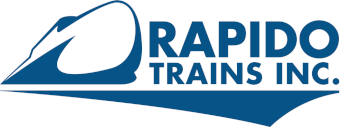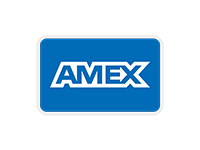Written by John Riddell. With thanks to Fred Headon and John Morris

Introduction
Of the steam locomotive designs operated by the Canadian Pacific Railway none was more universally employed than the D10-class Ten-Wheelers. A total of 502 of the sturdy, reliable and versatile machines were built by five builders over a nine year period from 1905 to 1913. The D10s were the most numerous class of steam locomotives in Canada.
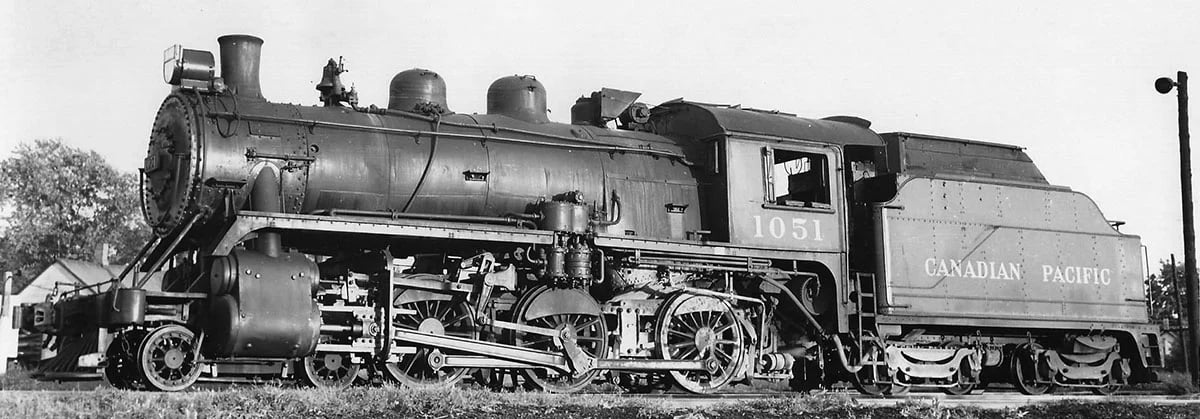
CPR D10h 1051 sits awaiting its next assignment at Woodstock, Ontario on August 7, 1954. James Walder photo, John Riddell collection.
The D10 design, introduced in 1905, was a reasonably powerful 4-6-0 which would be versatile and satisfy many different applications. No other class more completely and successfully fulfilled its roles. Orders for D10s were placed simultaneously with CPR Angus Shops, Montreal Locomotive Works and the Canadian Locomotive Company in Kingston, Ontario. Forty were built in the U.S.A. by Richmond Locomotive & Machine Works and Schenectady Locomotive Works. The cost of a D10 in 1910 was $16,286 (or about $432,072 in 2018 based on inflation) The D10 was designed and built during the administration of Henry H. Vaughan, assistant to the Vice President in charge of Motive Power for the Canadian Pacific Railway from 1904 to 1915. His eleven-year administration was without parallel for productivity and technical innovation. During that time, nearly 1,500 steam locomotives, 45 percent of all the locomotives the CPR ever owned, were added to the roster. All were new designs, many with new wheel arrangements. The D10 top speed was 65 mph but they were quite rough riding at higher speeds because there was no trailing truck to stabilize them. Add to that branchline track which was usually not good for much more than 35 mph. The D10 was a straight forward design, relatively easy to maintain, tough and dependable. D10s were well-liked by engine crews and shop forces and were used on almost all of CP’s lines across the country in both branch and mainline service.
Classes
Starting in 1905 the Canadian Pacific grouped its vast fleet of steam locomotives according to wheel arrangement and driving wheel diameter using an alpha-numeric system: A and B for 4-4-0; C, D and E for 4-6-0 etc. Class-letter D was applied to 4-6-0 engines with 63” diameter driving wheels. Each letter-class was further defined by a number; 1, 2, 3 etc.
Each class was further grouped into alphabetic subclasses based chronologically on the date each group was acquired. The D10 engines were grouped into ten subclasses a, b, c, d, e, f, g, h, j and k from 1905 to 1913.
The chart below highlights the different classes of D10 and their builders (see below the chart for builder acronyms). Build dates are listed corresponding to the road numbers, which are listed after the renumbering on 1912-1913: Pacific D10-class Locomotives
| Class | Builder* | Build Date | Road Numbers** |
|---|---|---|---|
| D10a | CLC | July-Sept 1905 | 700-709 |
| D10b | MLW | Jan-Mar 1906, July-Sept 1905, Mar-April 1906 | 685-699, 710-739, 750-759 |
| D10c | CLC | April-July 1906 | 670-684 |
| '' | MLW | April-May 1906 | 760-769 |
| '' | CPAN | July-Sept 1905, Feb-April 1906, Oct-Nov 1905 | 740-749, 770-779, 790-794 |
| D10d | RICH | April-July 1907 | 600-613, 615-624, 780 |
| '' | MLW | Sept-Oct 1907, Jan-Mar 1907, Oct 1907 | 614 & 625-639, 640-669 & 781, 782-784 |
| D10e | MLW | Sept-Nov 1908, Sept-Oct 1909 | 800-819, 833-842 |
| '' | CPAN | July 1909-Aug 1910 | 820-832, 848-869 |
| D10f | MLW | Oct 1909 | 843-847 |
| D10g | CPAN | Aug-Nov 1911 | 870-894, 913-933, 949-961 |
| '' | MLW | Oct 1911 | 934-948 |
| '' | CLC | Mar-June 1911 | 895-912 |
| D10h | MLW | May 1912-Jan 1913 | 987-1061 |
| '' | CLC | Oct-Dec 1913 | 1087-1111 |
| D10j | MLW | Oct 1912 | 962-986 |
| D10k | ALCO | Oct 1912 | 1062-1076 |
| '' | MLW | Oct-Nov 1912 | 1077-86 |
* Builders: MLW - Montreal Locomotive Works, CLC - Canadian Locomotive Company, CPAN - CPR Angus Shops, RICH - American Locomotive Company (Richmond Machine Works), SCHY - American Locomotive Company (Schenectady Works)
** Road Numbers listed are post-1914 when D10e/f/g/h #2600-2811 were renumbered to 800-961 and 987-1036 to align with other D10-classes.
CPR owned a total of 502 D10s. The 92 D10g engines, numbered 870 to 961, were acquired in 1910 and 1911 from CP Angus shops, the Canadian Locomotive Company (CLC) and the Montreal Locomotive Works (MLW). The 105 D10h engines, numbered 987-1061 and 1087-1111, were acquired in 1912 and 1913 from both CLC and MLW. The D10j engines were acquired from MLW in 1912 and numbered 962 through 986.
Design Features
Designed by H. Vaughan soon after he joined the CPR in 1904 from the Lake Shore & Michigan Southern Railway, the D10-class followed the design of the earlier D9s with the main difference being that the D9s had compound steam distribution and the D10s were simple, superheated locomotives. Vaughan was a great proponent of superheating and he can be credited with bringing the CPR into the modern age by building superheated engines and converting earlier compounds to superheating. Locomotives equipped with superheaters had a fuel saving of approximately 10%. Vaughan, assisted by mechanical engineer A.W. Horsey, designed and patented the Vaughan-Horsey superheater which was incorporated into most new D10s. At the end of 1906 the CPR had 88 locomotives equipped with Vaughan-Horsey superheaters. Between 1907 and 1911 many Schmidt, Robinson or Cole superheaters in many older D10s were replaced with Vaughan-Horsey devices. Simplicity, robustness and an ability to go more or less anywhere on the system ensured that the D10s enjoyed a long working life. While the D10g and D10h-classes were constructed with Vaughan-Horsey superheaters, many were later converted to Elasco Type ‘A’ superheaters. The D10g and D10h engines had 63-inch diameter drivers, 21” X 28” cylinders, an engine weight of 202,200 lbs., a total engine and tender in working order weight of 351,200 lbs, a maximum tractive effort of only 33,000 lbs, and overall wheel base 54’-1”. They were hand-fired coal burners with open cabs. The tender’s capacities were 5,000 Imperial gallons of water and 12 tons of coal. The coal bunker in the tender had wood-sided extensions.
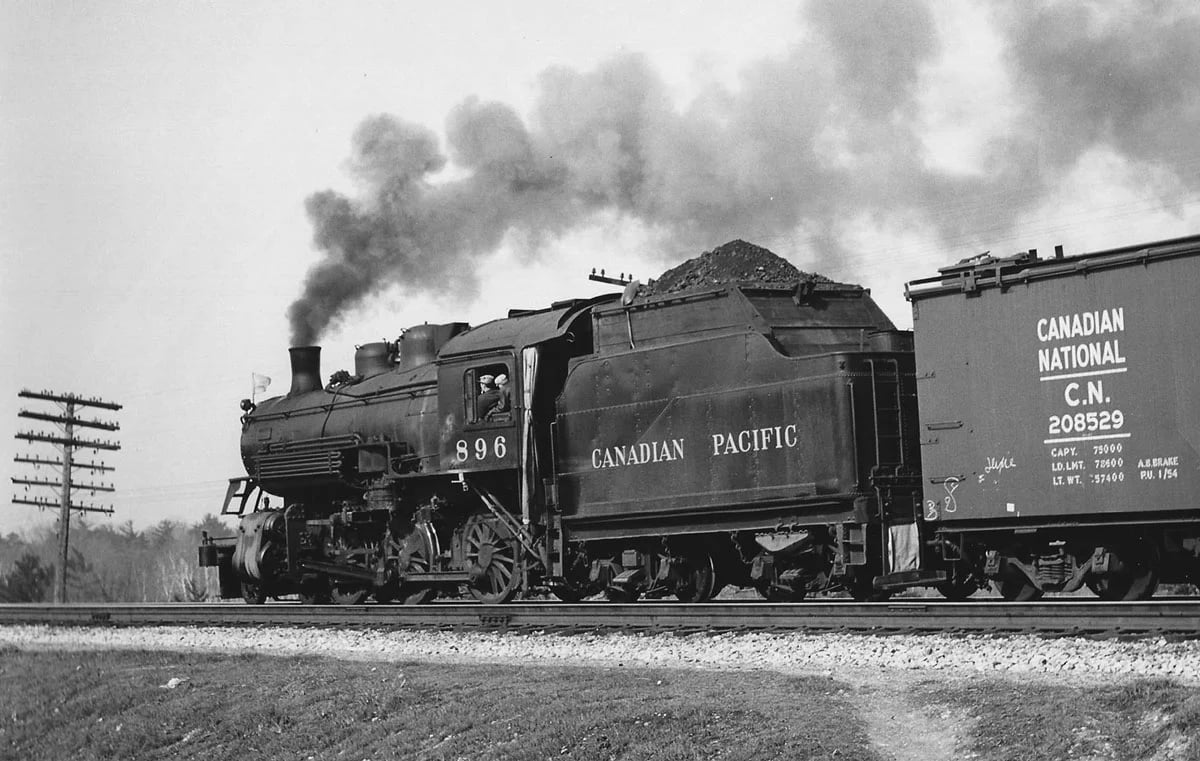
CPR D10g 896 is westbound at Lambton (West Toronto), Ontario on April 11, 1955. James Walder photo, John Riddell collection.
All were delivered with a single-cylinder air compressor but were later upgraded with a greater capacity Westinghouse “cross-compound” compressor. This enabled them to be used more effectively with longer trains, modern passenger cars with greater compressed air requirements, plows and Jordan spreaders without the issue of “running out of air”. The earliest members of the D10-class were fitted with Stephenson valve gear while the majority had Walschaerts valve gear. Many were delivered with a thin, curved valance beneath the running boards and cab. To protect the crew during cold weather, nine-foot long canvas curtains were hung from under the back of the cab roof where it overhangs the tender. When not required during warm weather the curtains were removed or drawn and gathered at each side of the cab.
Changes
When built, the engines were numbered in the 2700-series but in the 1912 reclassification of power, the D10g class were renumbered to the 900 series. When delivered, D10s had a half-moon headlight mounted on the top of the smoke box and a circular number plate in the center of the smokebox. Later many were fitted with a cylindrical Pyle-National headlight centered on the smokebox door and an illuminated number board on the top front of the smokebox. When delivered the bell was mounted behind the stack, but later many had the bell relocated to between the two domes. Some D10s were upgraded with a power reverse mechanism, a device that made switching movements easier for the engineer. It was located above or below the right-side running board.
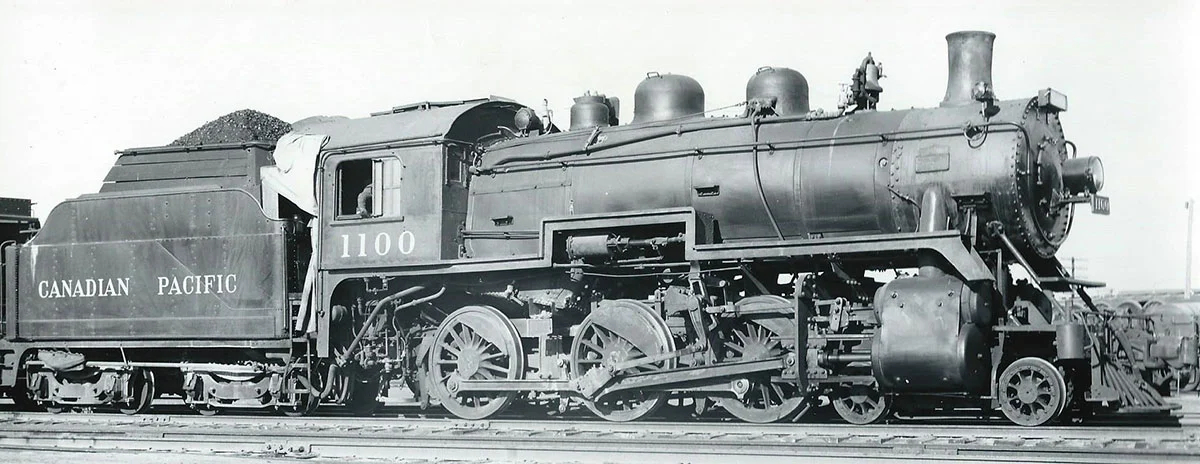
CPR D10h 1100 at rest in Swift Current, Saskatchewan on October 18, 1957. John Riddell collection.
From 1941 to 1956 a number of D10g/h engines were converted to burn Bunker C oil for service primarily in British Columbia. On January 1, 1944 seven had been converted to burn oil: 906, 907, 909, 910, 918, 920 and 925. On January 1, 1956, there were 19 converted to burn oil: 908, 909, 911, 914, 915, 918, 922, 923, 925, 936, 939, 962, 966, 969, 978, 983, 985, 1022 and 1026. Some D10s assigned to switching duties had footboards installed on their pilots and the back of their tenders. Examples were nos. 891, 896, 912, 924, 931, 945 and 999. Some D10s assigned to service in British Columbia were fitted with snow-plow pilots during the winter. Examples were nos. 901, 906, 908 and 910.
Assignments
Due to their adaptability in lighter assignments, D10s could be found in passenger, freight, mixed, work and yard service in virtually every terminal between Nova Scotia and British Columbia. D10s were widely assignment over the CPR system. On January 1, 1950 the 187 D10g and D10h engines in service were assigned as follows:
- British Columbia District - 15 units
- Alberta District - 17 units
- Saskatchewan District - 32 units
- Manitoba District - 22 units
- Algoma District - 7 units
- Ontario District - 30 units
- Quebec District - 32 units
- New Brunswick District - 16 units
- Dominion Atlantic - 9 units
- Quebec Central - 7 units
In 1951, 79 D10s were assigned to the following 13 terminals and division points in Saskatchewan:
- Saskatoon - 15 units
- Moose Jaw - 8 units
- Regina - 7 units
- Assiniboia - 6 units
- Broadview - 3 units
- Estevan - 4 units
- Kerrobert - 8 units
- Outlook - 2 units
- Prince Albert - 4 units
- Swift Current - 2 units
- Weyburn - 12 units
- Wilkie - 6 units
- Wynyard - 2 units
Often those assigned to the prairie region pulled an additional tender to boost water capacity on runs through alkali water areas. Similarly, in 1952, 38 D10s were assigned to the following eight terminals and division points in Alberta:
- Calgary - 6 units
- Lethbridge - 13 units
- Medicine Hat - 3 units
- South Edmonton - 4 units
- Empress - 1 unit
- Hardisty - 3 units
- Red Deer - 7 units
- Wetaskiwin - 1 unit
Some specific assignments in British Columbia were:
- D10g-class nos. 911 and 936 handled trains between Nelson and Midway BC in 1921-22.
- D10g-class no. 909 handled trains between Nelson and Trail from 1936 to 1940
- D10g-class nos. 954 and 955 handled the trains between Rossland and Midway BC
- No. 954 handled trains between Trail and Nelson from 1936 until 1949.
Dominion & Atlantic Railway
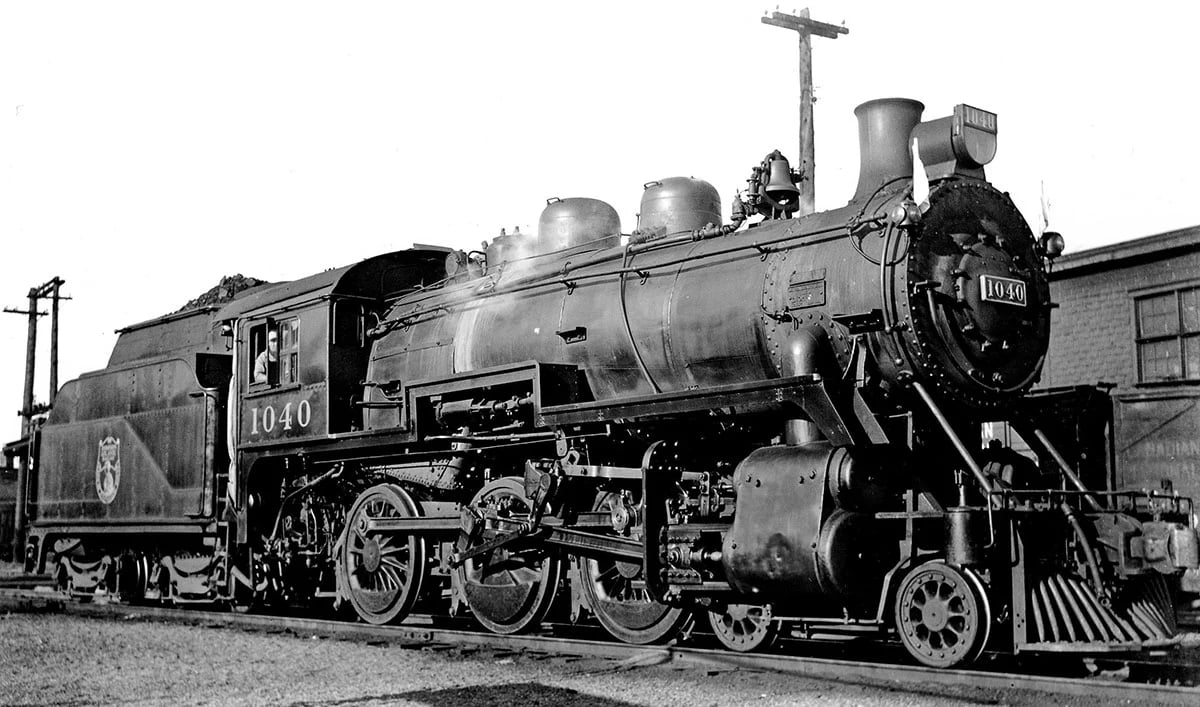
Dominion Atlantic D10h 1040. Unknown date. Brian Schuff collection.
Starting in 1937 the CPR loaned, leased or sold the following D10s to CPRs subsidiary in Nova Scotia, the Dominion Atlantic Railway: 903, 929, 999, 1015, 1018, 1020, 1027, 1038, 1040, 1041, 1046, 1050, 1067, 1077, 1079, 1089, 1090, 1092, 1101 and 1111. Four were named: no. 999 ‘Fronsac’, 1018 ‘Dermonts’, 1041 ‘Membertou’ and 1090 ‘Derazilly’. Most retained their CP lettering but several including nos. 1046 and 999 had their tender sides relettered with the distinctive DAR ‘Land of Evangeline Route’ logo.
Montreal & Atlantic Railway
From 1913 to 1931 CPR transferred three D10s – 868, 869 and 87 – to CPRs subsidiary Montreal & Atlantic Railway. The three were re-lettered for the M&A but retained their CPR road numbers.
Quebec Central Railway
CPR sold or leased the following D10g-class engines to CPR subsidiary Quebec Central Railway: 878, 940, 811, 844, 856, 866, 871, 873, 893, 948. Some were re-lettered with QUEBEC CENTRAL adorning the sides of the tender in place of the traditional CPR lettering.
Esquimalt & Nanaimo Railway
The following sixteen oil fired D10g-class engines were leased or assigned to CPR subsidiary Esquimalt & Nanaimo Railway on Vancouver Island from 1940 to 1949: 870, 901, 906 to 911, 914, 915, 918, 920, 922, 923, 925 and 926. They retained their CP lettering and road numbers while on the E&N.
Livery
The engine and tender were painted black overall. Cab interiors were finished in green with window sashes originally stained mahogany and varnished. After 1937 the sashes were painted Tuscan Red. Initially the D10s were delivered with their road number in large numerals centered on the tender sides. The cab sides were lettered with C.P.R. followed by the road number. The distinctive style of the letters and numbers was designed by George Bury, then vice-president of western lines.
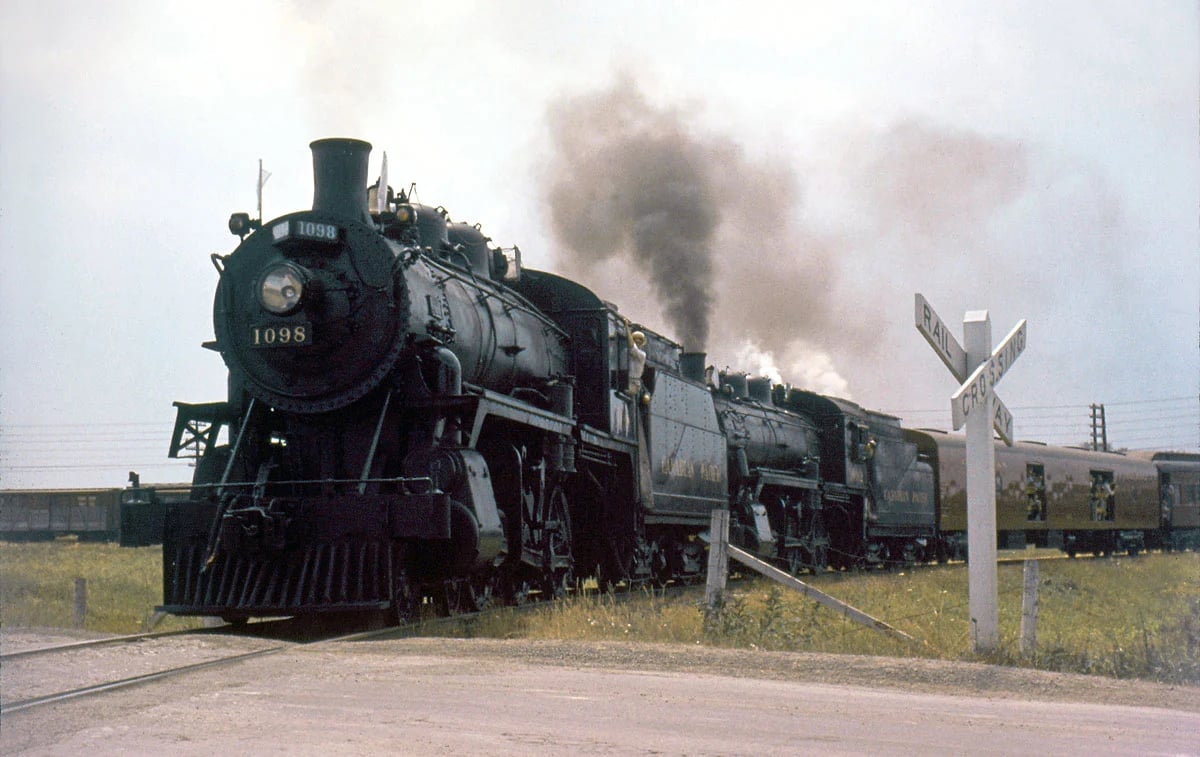
A pair of CPR D10h's - 1098 and 1092 - are on an NRHS fantrip at Streetsville Jct, Ontario, 19 July 1959. John Wagner photo, Dan Dell'Unto collection.
After 1928, D10s started to be repainted with CANADIAN PACIFIC in 10” roman letters centered horizontally and vertically on the tender sides. The locomotive road number appeared in twelve-inch numerals of corresponding style on the cab sides. Letters and numerals were painted in the standard “imitation gold” colour. Some D10s assigned to passenger service – such as no. 909 between Trail and Nelson, BC – had tenders which featured black panels framed with imitation gold ¾-inch wide striping around the standard CANADIAN PACIFIC lettering on the tender sides. They also featured white rimmed wheels (aka “white walls”) on the driving wheels and the those on the lead truck. D10s assigned to western lines also commonly had their smoke boxes painted graphite gray instead of the standard black.
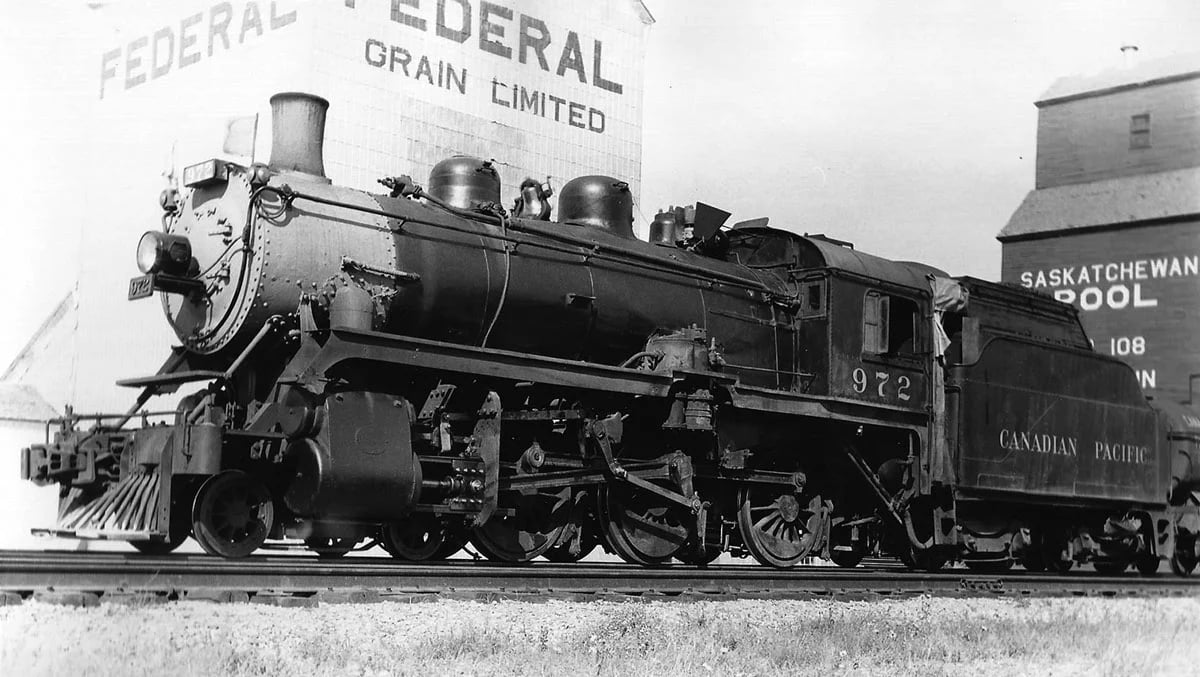
It's September 3, 1959 and CPR D10j 972 is seen in front of a pair of grain elevators at Chaplin, Saskatchewan. James Walder photo, John Riddell collection.
A single D10j, no. 962, carried CPR Tuscan red panels outlined in gold striping on its tender sides and below its cab windows, with a graphite coloured smoke box. It was assigned to the Sicamous-Kelowna (B.C.) mixed trains for many years.
Disposition
Most D10s were retired and scrapped during the late 1950s as CP acquired new diesels. Some sixty-one D10s were scrapped in the early 1960s. Of the 502 CPR class D10s built, seven are preserved today as follows:
- D10g-class 894 at the Waterloo Regional Museum, Kitchener, ON
- D10g-class 926 at the Canada Science and Technology Museum, Ottawa, ON
- D10j-class 972 at the Strasburg Rail Road at Strasburg, PA
- D10h-class 999 at the Canadian Railway Museum, Saint-Constant, QC
- D10h-class 1057 at the South Simcoe Railway, Tottenham, ON
- D10h-class 1095 in the Waterfront Park in Kingston, ON
- D10h-class 1098 at Rail Tours Inc. at Jim Thorpe, PA
Further References
Booth, Derek. Quebec Central Railway From the St.Francis to the Chaudiere, 2006
Classification and Dimensions of Locomotives. Chief of Motive Power & Rolling Stock, CP, 1945
Lavallee, Omer. Canadian Pacific Steam Locomotives, 1985
Lavallee, Omer. Delorimier & Angus, 1960
Lavallee, Omer and Brown, Robert. Railway & Locomotive Historical Society, Bulletin No. 83, “Locomotives of the Canadian Pacific Railway Company”, 1951
McQueen, D.R. and Thomson, W.D. Constructed in Kingston – A History of the Canadian Locomotive Companies 1854-1968, 2000
Ness, Gary W. The Dominion Atlantic Railway 1894-1994, 2014
Photopak: 16, D10-class 4-6-0, Railfare Enterprises Limited
Turner, R.D. and MacLachlan D. F. The Canadian Pacific’s Esquimalt & Nanaimo Railway, The Steam Years, 1905-1949, 2012
